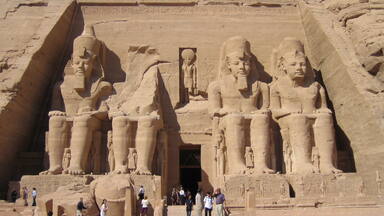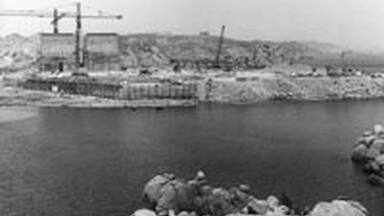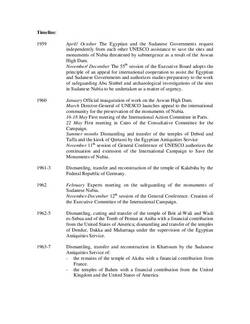The most famous of the monuments affected by the Aswan High Dam Project was the temple complex on the island of Philae. Sacred to the goddess Isis, the sanctuary dates mostly to the Graeco-Roman period and was later transformed into a church (540 AD).
The following monuments were also threatened by the construction of the dam:
- The small temples of Debod, Qertassi and Taffa, from the same period as Philae,
- the large temple of Kalabsha, built by Augustus to the local god Mandulis,
- the temple of Beit el Wali in vicinity of Kalabsha,
- the small Dendur temple further South,
- the rock temple of Ramses at Gerf Husein,
- the Dakka temple dating from the Ptolomaic times,
- the Roman period temple of Maharraqa,
- a temple of Ramses II at Wadi es Sebua,
- an old temple, built under the reign of Thutmosis III and Amenophis II (15th c. BC) at Amada, situated 205 km south of Aswan,
- the rock temple of Derr on the opposite, right bank of the Nile, dating to the period of Ramses II,
- a rock-cut chapel of Thutmosis III at Elleysia, just north of the fortified village of Qasr Ibrim, an important political centre in Roman times and later,
- the two rock temples of Ramses II at Abu Simbel, 280 km to the south of Aswan
- the small rock-cut chapel of Horemheb (end 14th c. BC) at Abu Oda on the opposite bank of the Nile, near the big fortified town of Gebel Adda (Roman and later).
In Sudanese Nubia, the following monuments and sites were endangered:
- the temple of Ramses at Aksha,
- the fortified town of Buhen with two temples of the 18th Egyptian Dynasty and
- two temples of the same period in the fortresses of Semna East and West.
Threatened by final submersion under 50 or so meters of water the need to salvage these above-mentioned, unique monuments was as urgent as it was technically challenging.
With three exceptions (the temple of Gerf Husein, the chapels of Qasr Ibrim and the temple of Abu Oda), the monuments were dismantled, carved up and moved to another site. They were reassembled in six groups:
- the temples of Philae island on the island of Agilkia near the former Aswan dam;
- the temples of Beit el Wali and Kalabsha and the Kiosk of Qertassi near the High Dam;
- the temples of Dakka, Maharraqa and Wadi es Sebua near the former site of Wadi es Sebua;
- the temples of Amada and Derr and Pennut's Tomb at Aniba near the former site of Amada;
- the temples of Abu Simbel in situ but 60 m above their original site;
- the temples of Aksha, Buhen, Semna East and Semna West in the museum garden in Khartoum.
In addition, Egypt donated four temples as tokens of its gratitude to countries which especially contributed to the success of the campaign: Debod to Spain, Taffa to the Netherlands, Dendur to the United States and Ellesyia to Italy.


